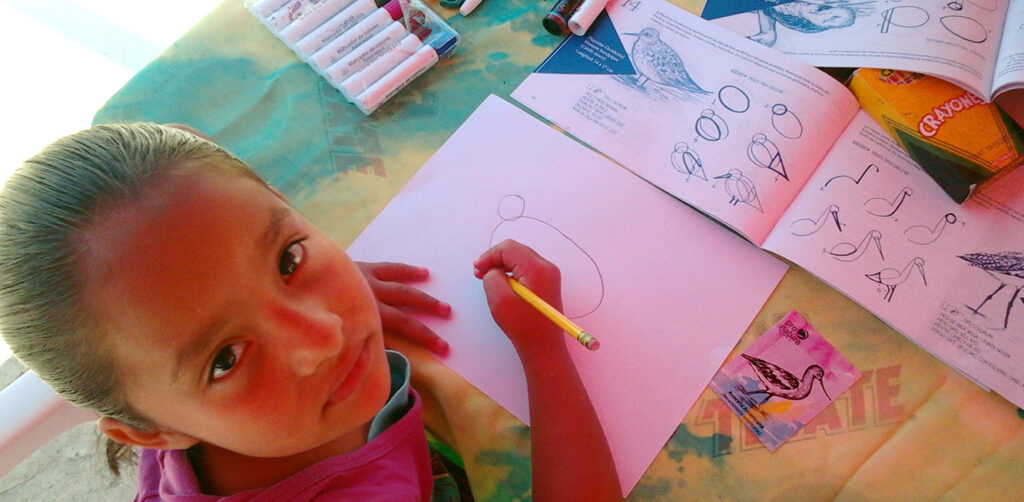Our Educational Platform for environmental conservation reaches students, teachers and community promoters
In recent decades, many organizations worldwide have pointed out critical threats to ecosystems and life on our planet, such as global warming, the production of single-use plastics, irresponsible waste management and pollution. To reverse this situation, there’s only one option left: to become environmentally conscious and live in harmony with nature.
We work every day to forge a change of mentality in individuals and communities. That is why we present you with our Educational Platform, a bank of educational resources, workshops and training courses, available free of charge. This platform is developed within the framework of Conservation Education and is aimed at teachers and students throughout the region, as well as fishermen, community leaders, decision makers and environmental promoters.
Here are some of the options contained in our platform:
Manual for teachers “Shorebirds and Wetlands. Teaching Strategies for their Conservation.” Presents detailed information about shorebirds and the challenges for their conservation. Aimed at teachers, educators and environmental promoters. The content is divided into several blocks, focusing on the evolution of birds from dinosaurs, their morphology and adaptability, their importance to ecosystems (especially wetlands in northwestern Mexico), and the main threats they face. The manual also includes useful tips for practicing bird watching.
Shorebirds and Wetlands e-course. This virtual course builds on the Manual for Teachers described above. It is divided into five modules and 18 lessons. The course contains theoretical information, informative videos, engaging activities, and initial and final evaluations. The objective is for the student to be able to replicate its content to others. It includes a list of actions to involve the community, as well as a certification for participants. To date, this virtual course has more than 2,410 visits and 9,681 visitors.
Shorebird educational trunk. This resource contains playful games related to the Shorebirds and Wetlands Manual and e-course. The most interesting thing is that the educational trunk was developed based on traditional games adapted to learn about shorebirds. To download the contents of these materials, click here.
Workbooks for children and youth. Consists of work guides for students, aligned to some school contents of Geography, Natural Sciences and Mathematics according to the different grades of Primary Education. It includes pages with activities (fanzine), concepts about wetlands and shorebirds, and games for children and adults. The booklet also provides access to the Shorebirds Didactic Trunk and to games and didactic materials such as “The Journey of Pizo, the Red Knot”, “PlayerOCA”, Memory and “Beat Climate Change”.
The journey of Pizo, the Red Knot. This game presents the migratory journey of this emblematic bird of the wetlands of northwestern Mexico, through a character, Pizo. This facilitates students’ understanding and empathy towards the conservation of this bird and its ecosystem.
PlayerOCA. This is the famous OCA Game, with which we describe the birds and their habitat in northwestern Mexico, in addition to highlighting the threats that put them at risk and actions for their conservation.
Shorebird Memory and Lottery. This version of the board games widely known in our country focuses on the characteristics of the most common bird species in the northwest of the country.
Beat Climate Change. This fun board game reflects on the consequences on the environment if the temperature rises and promotes local actions to minimize the impact.
We are proud to say that, to date, we have trained 644 teachers and environmental educators, as well as more than 5,000 students from 32% of the elementary schools in the northwestern coastal wetlands communities. In addition, the content of the Educational Platform has been used by Cornell Coastal Solutions grantees in San Quintín, Baja California, and La Paz, Baja California Sur. It has also served to enrich the Behavior Change Campaigns in Guerrero Negro, BCS, and the Gulf of Santa Clara, Sonora. Similarly, Ecology personnel from the municipality of Navolato, Sinaloa, and volunteers dedicated to environmental education in various communities in northwestern Mexico have had access to the platform’s tools.

Among the allies to make this material a reality are the Flora and Fauna Protection Areas (APFF), Gulf Islands in Sonora, the Biosphere Reserves (BR), Upper Gulf of California and El Vizcaino. We mention here some of the environmental promoters who actively collaborate in this work: Ernesto Abel Salmerón Pillado, Alma Valenzuela Moroyoqui, Adriana Hernandez Alvarez and Norma Soraida Gonzalez Bernal in Sonora; Nadya Guadalupe Aguilar Torres in Baja California; Alondra María Calderas Nonato in Nayarit; Jenifer Ayala Martinez, Jesús Ivan Guardado Gonzalez, Armando Martinez Murillo, Andres Avelino Medina Chaidez and Mayram Juliana Esperano Chaidez in Sinaloa. We thank all of them for their passion and dedication to shorebird conservation.

All these materials are intended to raise awareness of the importance of protecting shorebirds. In addition, the presence of migratory birds in our region is an indicator of the environmental conditions we have and the possible threats to the ecosystem. Therefore, to study in depth the migration of birds on the Pacific coast, we work with various organizations, research centers, and governments of several countries. This is done through a network of receiving stations, called Motus stations (Latin for movement), installed at strategic points on the continent. Each station´s antenna captures the movements of the birds, as some of them carry a small radio locator. The data is stored in a computer system used for conservation purposes.
We have an opportunity to continue protecting the birds. With education, monitoring, and your support, it is possible. We invite you to contribute with us, and together we can continue to make conservation a reality.












